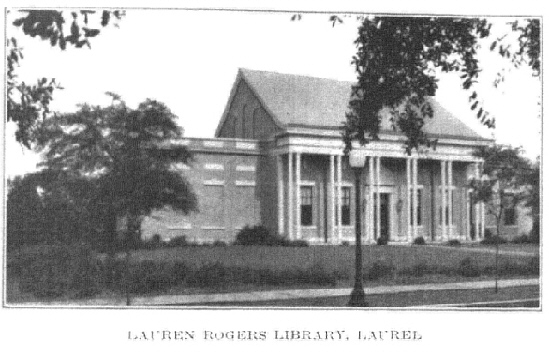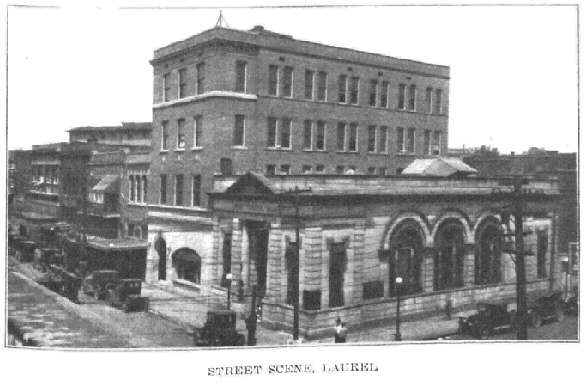.
Jones
County

JONES COUNTY
CHAPTER XLVI, pages 754 - 758
Jones is one of the prosperous and growing
counties in the southeastern part of the State and is noted for both its
manufacturing industries and agricultural progress. It was established
January 24, 1826, during the administration of Governor Holmes. It was
named in honor of Commodore John Paul Jones, the founder of the American
navy. It was formed from the counties of Covington and Wayne and its boundaries
were declared to be "all that part of Covington County lying west of the
center of range fourteen, and all that part of Wayne County lying west
of range nine." Its northern boundary is formed by the Old Choctaw line
established by the Treaty of Mt. Dexter, November 16, 1805, which divides
it from Jasper County, and its southern boundary is formed by the line
between townships five and six, which divides it from Perry County.

The first county officers in 1826 were
John Snow, Judge of Probate; John Moffit, Adam Shows, James Tate, Associate
Justices; William Ellis, Sheriff; Stacy Collins, Assessor and Collector;
Jason W. Movein, Coroner; Samuel Ellis, County Treasurer; John McCormick,
County Surveyor; Elisha Williams, Isaac Williams, Peter Loper, Jr., John
C. Thomas, John Nesom, Daniel Windham, Justices of the Peace; and William
McGehee, Ranger. It has a land surface of 696 square miles. Ten years later,
in 1836, the county had a population of only 1,017 whites and 108 slaves,
and, until the advent of the railroads, it remained one of the most sparsely
settled and unproductive counties in the whole State. The county seat is
Ellisville, located in the center of the county and containing a population
of 1,681 people in the year 1920. Ellisville is one of the "live" towns
in this part of the State, is on the line of the New Orleans & North
Eastern railroad, has a large cotton mill and is an important shipping
point for lumber, turpentine and other timber products. The region about
it is covered with a heavy growth of long leaf pine and possesses abundant
water power.

Jones is second only to Hinds County as
a manufacturing district. It has a greater number of wage earners than
Hinds County, but does not equal the latter in the value of its industrial
output. On the other hand its 56 establishments pay out more wages—$3,286,000—than
the 82 of Hinds County. The value of the manufactured products of Jones
County in 1919 was placed at $10,807,000. Of that amount Laurel contributed
$8,182,000. Laurel is by far the largest city in the county, and one of
the most important industrial centers in the State, the census of 1920
giving it a population of 13,037. It was 8,465 in 1910, and 3,193 in 1900.
No city in the State has had such a rapid or solid growth as Laurel, nor
a more cultured, progressive people. The city owes much to the great manufacturing
company of Eastman, Gardiner & Company, who have contributed so freely
to its financial and cultural advancement. It has unexcelled shipping facilities
over three lines of railroad—the Gulf, Mobile & Northern, the New Orleans
& Northeastern and the Gulf & Ship Island. No city in Mississippi
distributes larger quantities of the pine for which this region has become
famous in the shape of lumber and timber than Laurel. It derives its name
from the dense laurel thickets which formerly grew within its limits. Some
of the other towns in the county are Blodgett, Sandersville, Estabutchie
and Soso. They are railroad towns.
The county is well watered by the Leaf
River, which flows through the western sections, and by the Tallahalla,
Tallahoma and Bogue Torno creeks, down which the log drives are made to
the numerous sawmills of the region. The county is located in the long
leaf pine belt of the State and is still finely timbered. The soil is generally
thin and sandy on the uplands, but fertile in the creek and river bottoms.
Besides setting forth the high standing
of Jones County as an industrial section, the census of 1920 indicates
its wealth in the agricultural line. Its farm property is valued at $6,969,000
and the crops raised in the county during 1919 brought $2,477,000 to the
husbandman. From the 24,000 acres given over to the cultivation of cotton,
more than 5,000 bales were provided for the market. Jones County raises
an abundance of nuts; for the year named more than 49,000 pounds were harvested,
most of them pecans.
Jones County has steadily increased in
population, as well as in wealth, the period 1860-70 being a natural exception.
In 1850 its population was 2,164; 1870, 3,313; 1890, 8,333; 1910, 29,885;
1920, 32,919. The county affords great opportunities and its continued
advancement is assured. Its schools, churches and homes are built according
to beautiful and permanent models.
Return to
County History Index
MSGenWeb Home
Source:
Mississippi The Heart of the South - By Dunbar Rowland, LL.D - Director
of the Mississippi State Department of Archives and History. Vol.
II Illustrated. Chicago-Jackson; The S. J. Clarke Publishing
Company, 1925. Public Domain
Copyright Notice: All files
and photographs on this site are copyrighted by their creator and/or contributor,
unless otherwise noted. They may be linked to but may not be reproduced
on another site without specific permission from The MSGenWeb State Coordinator
or the Assistant State Coordinator, and/or their contributor. Although
public information is not in and of itself copyrightable, the format in
which they are presented, the notes and comments, etc., are. It is however,
quite permissible to print or save the files to a personal computer for
personal use ONLY.
  
|






